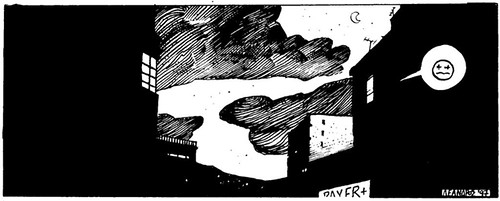Return to Panic

[Image: Illustration by Leandros, from Issue Two of Occupied London, 2007.]
A few months ago I discovered a budding new journal called Occupied London dedicated to global activism and social movements, which in its first issue featured an interview with Mike Davis about resisting the copious snares of urban surveillance networks, as well as an article by Franco Berardi who described the nature of contemporary cities as being constituted by a kind of medium of urban panic.
You may remember, I wrote a response to that piece here on Subtopia exploring panic as an urban developer of sorts; panic as the de facto architect of many of the structures we find cropping up in the spatial craze of the war on terror - panic spatialized, if you will.
Anyway, in case you missed it Occupied London has published Urbanization of Panic in their current and second issue. It is more or less the same piece I originally wrote though it has been dusted with a few more thoughts here and there. You can read it in its entirety right here, and even download it as a PDF, if you wish. In short, let me post this extract:
Taking the City of Panic a bit further in Subtopian terms I ask, has panic become the main ingredient that binds the urban experience today – spread through a larger geopolitical climate as well? If we think of so-called globalization and the 'War on Terror' purely in terms of the spaces it occupies, we could examine the implicit panic in structures like border fences and illegal immigration detention centers, leftover bunkers and future secret fallout space; or in the atmospheres of urban conflict zones like the Occupied Territories; or from behind the walls of the new American embassy compound in Baghdad – there are entire cartographies of paramilitarism and slumaphobia to be traced across the map. The urban morphology of panic has left behind entire Cold War landscapes once modeled on a panic preparedness. Berardi likens this ubiquitous panic to an electrical charge, but I also see it is a critical vibration in some way - or, maybe more like a resident frequency that signifies the simultaneous (in)stability of the global city's core social and structural foundations. Panic as a volatile urban harmony. We have engineered a range of metropolises that vibe on the edge of collapse at every level. [...]
It is not entirely unobvious that panic appears almost as if it were a chief modus operandi for much of the world’s planning strategy. We've moved past the kind of bombastic but functional fear that the nuclear threat brought towards a more dysfunctional domestic terror that keeps everything on edge – both within the zones of safety now as well as outside the gates – where at any moment something on a smaller local scale could suddenly cause considerable mayhem. Either way the current urban response is less on how to unravel the causes of such a crisis and more so on how to armor ourselves from its penetration – a posture rooted in a perpetual state of anticipated panic, a great looming panic attack, ultimately a state of terror. [...]
One might ask, based on the panic-stricken nature of western culture what is the current diagnosis and mental health state of neo-liberal democracy? Or, how can the city be viewed as an architectural weapon to enforce a certain behavioral code, or to forcefully spatialize neo-liberalism in a way, to rear obedience (or addiction) to a rampant commerce? What are the inherent narratives of power that run through constructs like maximum-security prisons, megalithic casinos, shopping mall complexes, refugee camps, suburban sprawl, torture spaces and the hardened borderzones between nation-states? Is there a psychopathological connection between them all? Is there a new urban geopolitical archetype here to be deconstructed? I suppose to some degree Subtopia is an attempt to document these realms of spatial politics and the psychological underpinnings that govern these globalized architectures of control – these Cities of Panic.
With that, be sure to check out the rest of the issue with some great pieces on the uprisings in the Parisian banlieus, the legacy of revolts in South Africa’s cities, the nature of ‘urban unrest’, and a special portion dedicated to the recent G-8 Summit in Rostock, Germany. And, don’t be afraid to order a printed copy of the journal for posterity!







0 Comments:
Post a Comment
<< Home